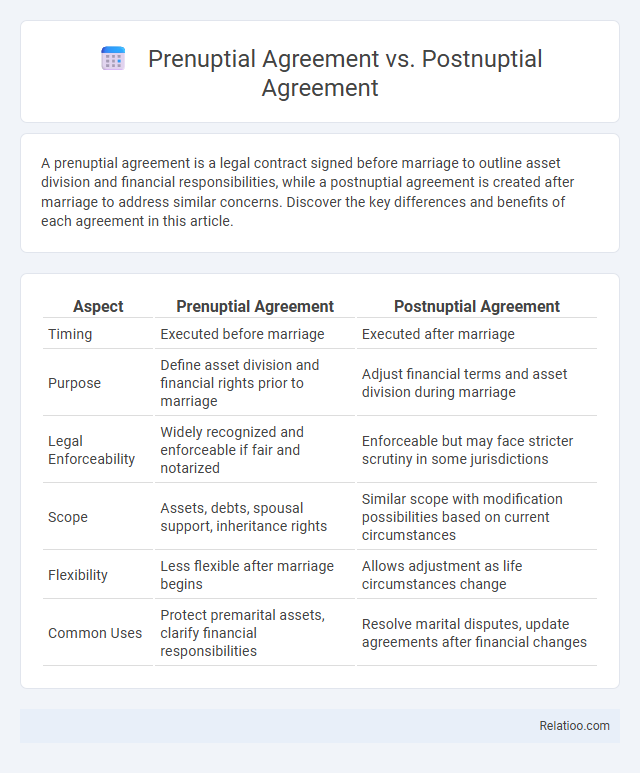A prenuptial agreement is a legal contract signed before marriage to outline asset division and financial responsibilities, while a postnuptial agreement is created after marriage to address similar concerns. Discover the key differences and benefits of each agreement in this article.
Table of Comparison
| Aspect | Prenuptial Agreement | Postnuptial Agreement |
|---|---|---|
| Timing | Executed before marriage | Executed after marriage |
| Purpose | Define asset division and financial rights prior to marriage | Adjust financial terms and asset division during marriage |
| Legal Enforceability | Widely recognized and enforceable if fair and notarized | Enforceable but may face stricter scrutiny in some jurisdictions |
| Scope | Assets, debts, spousal support, inheritance rights | Similar scope with modification possibilities based on current circumstances |
| Flexibility | Less flexible after marriage begins | Allows adjustment as life circumstances change |
| Common Uses | Protect premarital assets, clarify financial responsibilities | Resolve marital disputes, update agreements after financial changes |
Introduction to Prenuptial and Postnuptial Agreements
Prenuptial and postnuptial agreements are legal contracts designed to outline financial rights and responsibilities between spouses, with prenuptial agreements established before marriage and postnuptial agreements created after marriage. These agreements protect Your assets, manage debts, and provide clarity in case of divorce or separation. Understanding these contracts is essential for blended families, where financial matters can become complex due to previous marriages or children from prior relationships.
Defining Prenuptial Agreements
Prenuptial agreements are legal contracts created before marriage to outline asset division, financial responsibilities, and debt management in case of divorce or separation. These agreements provide clarity and protection for both parties, especially when individuals bring significant assets, children from previous relationships, or business interests into the marriage. Unlike postnuptial agreements, which are formed after marriage, prenuptial agreements proactively address financial arrangements, ensuring transparency and reducing potential conflicts in blended family dynamics.
Defining Postnuptial Agreements
Postnuptial agreements are legal contracts executed after marriage to address the division of assets, financial responsibilities, and spousal support in case of divorce or separation. Unlike prenuptial agreements signed before marriage, postnuptial agreements adapt to changes that occur during the marriage, such as acquiring new property or managing blended family finances. These agreements protect both spouses' interests, especially in blended families, where the distribution of assets and inheritance rights may become complex.
Key Differences Between Prenuptial and Postnuptial Agreements
Prenuptial agreements are created before marriage to outline asset division and financial responsibilities, while postnuptial agreements are established after marriage, often in response to changed circumstances. Both agreements protect individual interests, but prenuptial agreements tend to be proactive, and postnuptial agreements are reactive to events such as financial shifts or blended family concerns. You should consider the timing, legal enforceability, and family dynamics when choosing between these agreements to ensure clear estate planning and asset protection.
Legal Requirements for Enforceability
Prenuptial agreements require full financial disclosure from both parties before marriage and must be signed voluntarily with independent legal counsel for enforceability. Postnuptial agreements also demand fair disclosure and voluntary consent but are executed after marriage, often scrutinized more closely for duress or undue influence. In blended families, both types of agreements need clear, specific terms addressing the interests of children from previous relationships to withstand legal challenges.
Common Provisions in Prenups and Postnups
Common provisions in prenuptial and postnuptial agreements often include asset division, debt allocation, spousal support, and inheritance rights to protect both parties' financial interests. These agreements typically outline how property acquired before and during the marriage will be handled, ensuring clarity and minimizing disputes. Your blended family's unique financial dynamics may require tailored clauses addressing stepchildren's inheritance and support obligations.
Pros and Cons of Prenuptial Agreements
Prenuptial agreements offer clear advantages such as protecting individual assets, establishing financial rights, and reducing conflicts during divorce, but they can also create tension before marriage and may be challenged if not properly executed. Postnuptial agreements provide flexibility by allowing spouses to address financial matters after marriage but may lack the upfront clarity of prenuptial agreements. In blended families, prenuptial agreements help clarify inheritance and financial responsibilities, though careful consideration is needed to balance interests among all family members and avoid potential disputes.
Pros and Cons of Postnuptial Agreements
Postnuptial agreements provide couples the flexibility to address financial and property arrangements after marriage, offering clarity and protection in cases of divorce or death, but they may be viewed with suspicion or cause marital tension. Unlike prenuptial agreements signed before marriage, postnuptial agreements can be harder to enforce if one party claims coercion or if state laws are restrictive. For blended families, postnuptial agreements are valuable tools to safeguard the interests of children from previous relationships while balancing new financial responsibilities.
When to Consider Each Agreement
Consider a prenuptial agreement before marriage to clearly outline asset division and financial responsibilities in case of divorce, protecting individual property rights. A postnuptial agreement is best suited for couples already married who want to update or clarify financial terms due to changes in circumstances like income, debt, or blending families. If Your family involves stepchildren or previous marriages, a blended family agreement can help manage inheritance, custody, and support issues, ensuring fair treatment for all parties involved.
Conclusion: Choosing the Right Marital Agreement
Selecting the appropriate marital agreement--prenuptial, postnuptial, or arrangements tailored for blended families--depends on timing, individual financial circumstances, and family dynamics. Prenuptial agreements provide protection before marriage, while postnuptial agreements address changes after marriage, and specialized agreements for blended families accommodate the complexities of stepchildren and asset distribution. Legal consultation ensures the agreement matches specific needs, safeguarding assets and clarifying rights within each unique marital situation.

Infographic: Prenuptial Agreement vs Postnuptial Agreement
 relatioo.com
relatioo.com